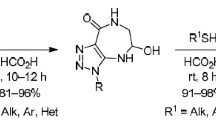Abstract
A synthetic procedure for the preparation of indole-2,3-dione derivatives6 as a potential NMDA receptor glycine site antagonist with improved pharmacological profile compared with 2-carboxyindole derivative5, starting from readily available 3,5-dichloraniline (7), is described.
Similar content being viewed by others
References
Cai, S. X., Kher, S. M., Zhou, Z. L., Ilyin, V., Espitia, S. A., Tran, M., Hawkinson, S. E., Woodward, R. M., Weber, E. and Keana, J. F., Structure-activity relation-ships of alkyl-and alkoxy-substituted 1,4-dihydro-quinoxaline-2,3-diones: Potent and systemically active antagonists for the glycine site of the NMDA receptor.J. Med. Chem., 40, 730–738 (1997).
Epperson, J. R., Hewawasam, P., Meanwell, N. A., Boissard, C. G., Gribkoff, V. K. and Postmunson, D., Synthesis and excitatory Amino acid pharmacology of some novel quinoxalinediones.Biomed. Chem. Lett., 3, 2801–2804 (1993).
Fabio, R. D., Capelli, A. M., Conti, N., Cugola, A., Donati, D., Feriani, A., Gastaldi, P. and Gaviraghi, G., Substituted indole-2-carboxylates as in vivo potent antagonists acting as the strychnine-insensitive glycine binding site.J. Med. Chem., 40, 841–850 (1997).
Honore, T., Davies, S. N., Drejer, J., Fletcher, E. J., Jacobsen, P., Lodge, D. and Nielsen, F. E., Quinoxalinediones: Potent competitive non-NMDA glutamate receptor antagonists.Science, 241, 701–703 (1988).
Huettner, J. E., Indole-2-carboxylic acid: A competitive antagonist of potentiation by Glycine at the NMDA receptor.Science, 243, 1611–1613 (1989).
Hwang, K., Synthesis of 7,8-Dichloro-6-Nitro-1H-1,5-Benzodiazepine-2,4-(3H, 5H)-dione as a Potential NMDA Receptor Clycine Site Antagonist.Arch. Pharm. Res., 23, 31–34 (2000).
Iversen, L. L. and Kemp, J. A., Noncompetitive NMDA antagonists as drugs. In the NMDA Receptor, 2nd ed., Collingridge, G. L., Watkins, J. C. (Eds.), IRL press, Oxford, England, pp 469–486 (1994).
Johnson, J. W. and Ascher, P., Glycine potentiates the NMDA response in cultured mouse brain neurons.Nature, 325, 529–531 (1987).
Kemp, J. A. and Leeson, P. D., The glycine site of the NMDA receptor-Five years on.Trends pharmacol. Sci., 14, 20–25 (1993).
Kulagowski, J. J., Glycine-site NMDA receptor antagonists:An update, Exp. Opin. Ther. Pat., 6, 1069–1079 (1996).
Lackey, K., Besterman, J. M., Fletcher, W., Leitner, P., Morton, B. and Sternbach, D. D., Rigid analog of campothecin as DNA topoisomerase I inhibitor.J. Med. Chem., 38, 906–911 (1995).
Leeson, P. D., Baker, R., Carling, R. W., Curtis, N. R., Moore, K. W., William, B. J., Foster, A. C., Donald, A. E., Kemp, J. A. and Marshall, G. R., Kynurenic acid derivatives. Structure-activity relationships for excitatory amino acid antagonism and identification of potent and selective antagonists at the glycine site on the NMDA receptor.J. Med. Chem., 34, 1243–1252 (1991).
Leeson, P. D., Carling, R. W., Moore, K. W., Moseley, A. M., Smith, G. D., Stevenson, G., Chan, T., Baker, R., Foster, A. C., Grimwood, S., Kemp, G. A., Marshall, G. R. and Hoogsteen, K., 4-Amido-2-carboxytetrahydroquinolines. Structure-activity relationships for antagonism at the glycine site of the NMDA receptor.J. Med. Chem., 35, 1954–1968 (1992).
Leeson, P. D. and Iversen, L. L., The glycine site on the NMDA receptor: Structure-activity relationship and therapeutic potential.J. Med. Chem., 37, 4053–4067, (1994).
McQuaid, L. A., Smith, E. C. R., Lodge, D., Pralong, E., Wikel, J. H. and Calligaro, D. O., 3-Phenyl-4-hydroxy-2-quinolin-2(1H)-ones: Potent and Selective antagonists at the strychnine-insensitive glycine site on the NMDA receptor complex.J. Med. Chem., 35, 3423–3425 (1992).
McCullough, J., Excitatory amino acids antagonists and their potential for the treatment of ischaemic brain damage in man.J. Clin. Parmaco., 34, 106–114 (1992).
Meldrum, B., Protection against ischaemic neuronal damage by drugs acting on excitatory neurotransmission.Cerebrovasc. Brain Metab. Rev., 2, 27–57 (1990).
Rawley, M., Leeson, P. O., Grimwood, S., Foster, A. C. and Saywell, K., 2-Carboxy Indolines and indoles as potential glycine/NMDA antagonists; Effect of five membered ring conformation on affinity.Biomed. Chem. Lett., 2, 1627–1630 (1992).
Rothman, S. M. and Olney, J. W., Excitotoxicity and the NMDA receptor.Trends Neurosci., 10, 299–302 (1987).
Salituro, F. G., Harrison, B. L., Baron, B. M., Nyce, P. L., Stewart, K. T., Kehne, J. H., White, H. S. and McDonald, I. A., 3-(2-carboxyindol-3-yl)propionic acid-based antagonists of the NMDA receptor associated glycine binding site.J. Med. Chem., 35, 1791–1799 (1992).
Author information
Authors and Affiliations
Corresponding author
Rights and permissions
About this article
Cite this article
Hwang, KJ., Lee, Ts. Synthesis of 4,6-dichloro-3-[(1-N-arylaminocarbonyl)-hydrazono]-1,3-dihydro-indole-2-one as a potential NMDA receptor glycine site antagonist. Arch Pharm Res 23, 112–115 (2000). https://doi.org/10.1007/BF02975498
Received:
Issue Date:
DOI: https://doi.org/10.1007/BF02975498



